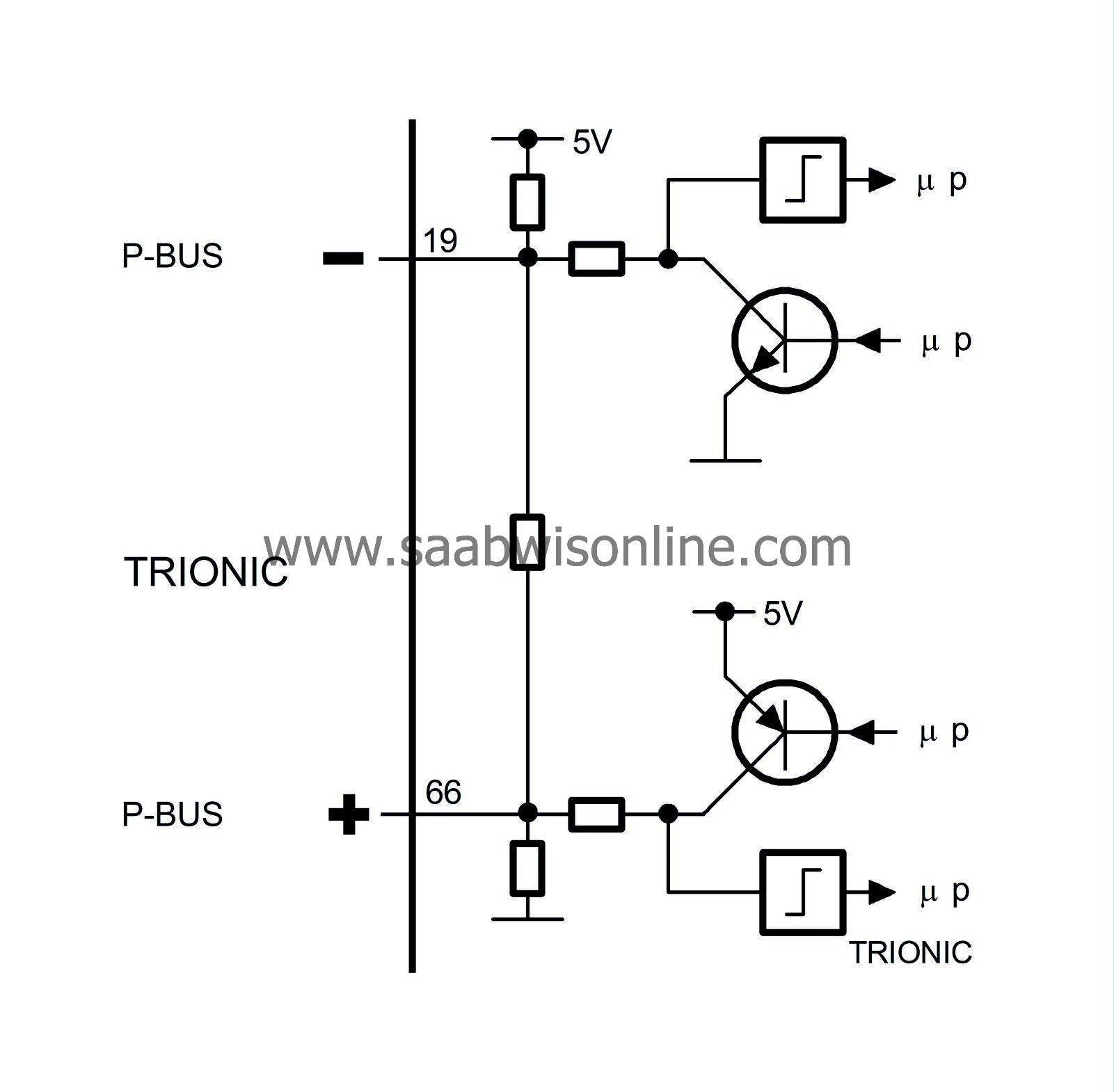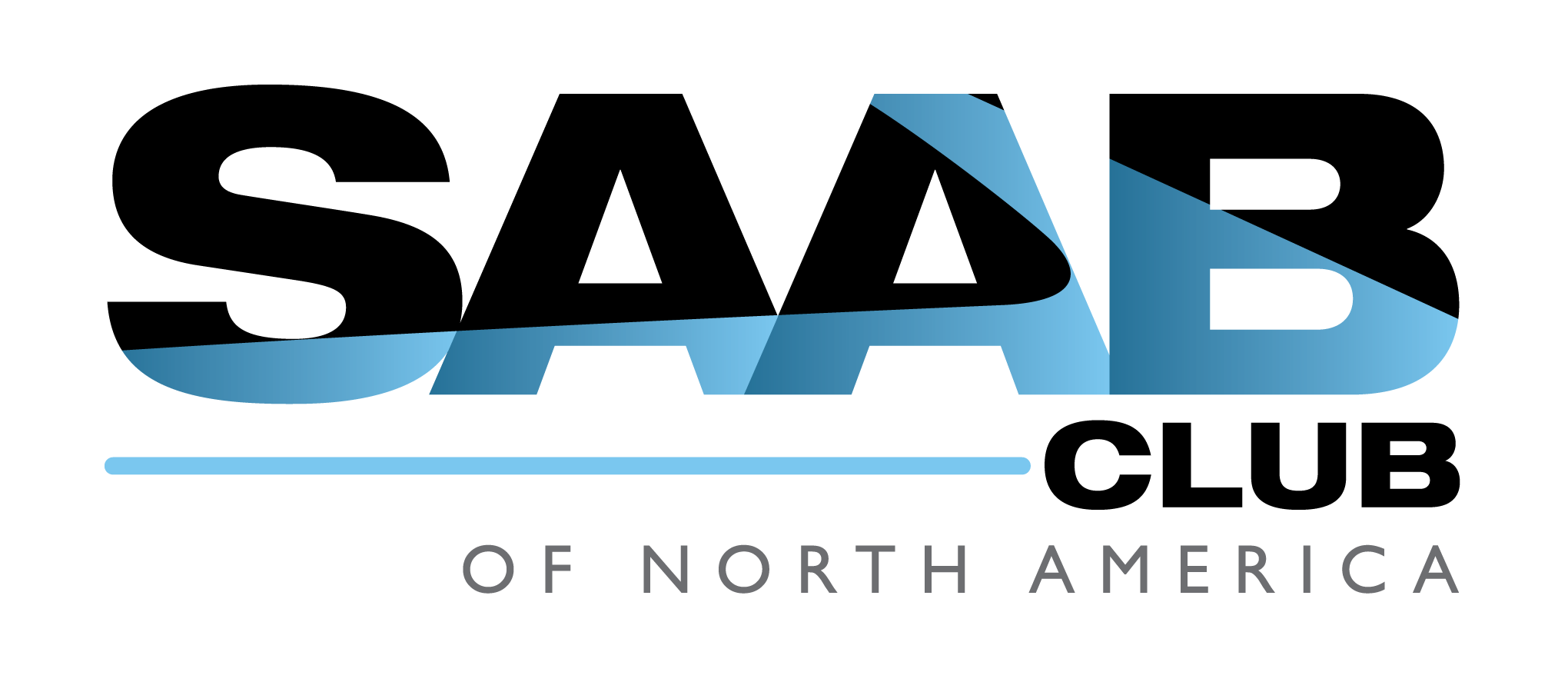Bus communication
| Bus communication |
| • |
Trionic T7 engine control module (589)
|
|
| • |
TCM control module (502)
|
|
| • |
MIU control module (540)
|
|
| • |
DICE control module (628)
|
|
| • |
Data link connector (445)
|
|
| • |
SID control module (541)
|
|
| • |
Audio control module (353)
|
|
| • |
ACC control module (216)
|
|
| • |
CD changer control module (355)
|
|
| • |
PSM control module (357)
|
|
| • |
TWICE control module (632)
|
|
| • |
PMM control module (611)
|
|
| • |
ABS (547), TC/ABS (382) control modules
|
|
| • |
Airbag control module (331)
|
|
| P bus and I bus |

In the Saab 9-5, all the car's control modules are connected to buses with the exception of the ABS and SRS control modules.
The buses are divided into the Powertrain bus (P bus) and the Instrument bus (I bus). Both buses are connected to the main instrument unit (MIU). The buses are electrically isolated from each other.
The P bus has a data transfer rate 10 times higher than that of the I bus.
All information sent out by a control module is available to all other control modules connected to the bus. The MIU ensures that the information which is available on one bus is also available on the other.
The control module sends out information on the bus at regular intervals. The time between two transmissions depends on the information being transmitted and varies between 10 milliseconds (0.010 seconds) and one second. Information is also sent out by the control module whenever the information changes.
The transfer of information between control modules takes place on two leads, BUS+ (green lead) and BUS- (white lead). The two leads are twisted to reduce sensitivity to electrical interference.
| Diagnostics |
In a bus system, all units must be able to communicate with each other. For example, the engine cannot be started unless the Trionic T7 can receive the immobilization information sent out by TWICE.
Permanent bus faults
All communication between the diagnostic tool and systems connected to the bus takes place through DICE. Irrespective of which system is contacted, the diagnostic tool first checks by means of DICE that all on-board systems connected to the bus are turned on and are communicating. If any control module connected to the bus is missing, the diagnostic tool will show this. This means that all control modules connected to the bus are communicating properly unless the diagnostic tool warns otherwise.Intermittent bus faults
Trionic checks continuously that TCM and MIU are communicating properly. Intermittent faults in the bus communication will generate diagnostic trouble codes. The cause of the fault may be that the supply of current to the control module concerned has failed or that one of the bus leads is missing.| Missing control module | DTC |
|
TCM
|
P1923
|
|
MIU
|
P1908
|
| The Trionic T7 uses the following information: |
| Information | Sensor system | |
|
Maximum permitted torque (Nm)
|
TCM
|
The TCM sends maximum permitted torque, unit Nm. The value is used in the air mass control system for engine torque limitation.
|
|
Sport mode selected (ON/OFF)
|
TCM
|
The TCM sends sport mode, unit ON/OFF. The value is used in the air mass control system to correct the pedal position conversion to the requested air mass/combustion.
|
|
Selector lever position, automatic transmission (PRND321)
|
TCM
|
The TCM sends selector lever position, unit PRND321. The value is used in the air mass control system for idle speed control.
|
|
Vehicle speed, left rear wheel (km/h)
|
MIU
|
The MIU sends speed, unit km/h. The value is used by the cruise control and is a substitute for the speed signal from ABS should it disappear.
|
|
Reverse gear selected (ON/OFF)
|
DICE
|
DICE sends reverse gear selected, unit ON/OFF. The value is used to determine whether first gear or reverse is engaged as the gear ratio does not adequately distinguish between these gears.
|
|
A/C request (ON/OFF)
|
DICE
|
DICE sends out A/C request, unit ON/OFF. The value is used in the air mass control system, compensation, to compensate for the increase in load. The control module also activates the A/C relay.
|
|
A/C pressure, high pressure side (bar)
|
DICE
|
DICE sends out pressure, unit bar. The value is used in the air mass control system, compensation, to calculate the increase in load before the A/C compressor is activated.
|
|
Current consumption (A)
|
DICE
|
DICE sends the calculated current consumption of the electrically heated rear window and radiator fan immediately before they are activated, unit A. The value is used in the air mass control system, compensation, to compensate for the load increase.
|
|
Brake lights (ON/OFF)
|
TWICE
|
TWICE sends out brake lights, unit ON/OFF. The value is used in the air mass control system for engine torque limitation.
|
|
Fuel level (Litres)
|
MIU
|
MIU sends out fuel level, unit Litres. The value is used in the on board diagnostics to generate special diagnostic trouble codes when misfiring occurs in connection with low fuel levels and to adapt the value of the tank pressure sensor.
|
|
CHECK ENGINE Request (ON/OFF)
|
TCM
|
TCM sends out request, unit ON/OFF. The value is used in the on-board diagnostics to turn on the CHECK ENGINE lamp when ON is sent. Diagnostic trouble code P1624 is generated to indicate a that the fault is located in the TCM.
|
|
Immobilizer (ON/OFF)
|
TWICE
|
TWICE sends immobilizer, unit ON/OFF. The value is used in the fuel injection system to activate fuel shut-off.
|
|
Ignition +50 circuit (ON/OFF)
|
DICE
|
DICE sends out +50, unit ON/OFF. The value is used for diagnosis of the crankshaft position sensor.
|
|
Diagnostics
|
DICE/diagnostic tool
|
The diagnostic tool sends diagnostic request via DICE, no unit. The value is used to respond to the request concerned.
|
| The Trionic T7 sends out the following information: |
| Information | User System | |
|
Engine torque (Nm)
|
TCM
|
The current air mass/combustion is converted into torque, unit Nm. The value is used by the TCM.
|
|
Accelerator pedal position (%)
|
TCM
|
The highest of the air mass/combustion values from the accelerator pedal position or cruise control is selected. The value is converted to the corresponding accelerator position in percent. The value is used by TCM.
|
|
Kickdown (ON/OFF)
|
TCM
|
When the voltage from pedal potentiometer 1 corresponds to the kickdown position (less than 1.50 V), kickdown ON, unit ON/OFF, is sent. The value is used by the TCM.
|
|
Engine speed (rpm)
|
MIU, TCM and ACC
|
The current engine speed is sent, unit rpm. The value is used by the TCM, ACC and MIU.
|
|
Coolant temperature (°C)
|
MIU, DICE and ACC
|
The current temperature is sent, unit °C. The value is used by ACC, MIU and DICE.
|
|
Engine running (ON/OFF)
|
ACC, DICE
|
ON, unit ON/OFF, is sent when engine speed exceeds 650 rpm. The value is used by the ACC and DICE.
|
|
Tighten fuel filler cap (ON/OFF)
|
SID
|
If the tank integrity diagnosis indicates a leak, ON, unit ON/OFF, is sent. The value is used by SID.
|
|
Turbo/APC gauge value (No unit)
|
MIU
|
The current air mass/combustion is converted to a value between 0 and 255. The value is used by MIU.
|
|
CHECK ENGINE (ON/OFF)
|
MIU
|
ON, unit ON/OFF, is sent when On-board diagnostics reports that the lamp should be lit. The value is used by the MIU.
|
|
SHIFT UP (ON/OFF)
|
MIU
|
ON, unit ON/OFF, is sent when running with a light load and high rpm, and at very high rpm irrespective of load. The value is used by the MIU.
|
|
CRUISE lamp (ON/OFF)
|
MIU
|
ON, unit ON/OFF, is sent when cruise control is activated with the switch. The value is used by the MIU.
|
|
Fuel used since start (ml)
|
MIU
|
The value is 0 ml when the ignition is switched on and is then incremented for each injection, unit ml. The value is used by the MIU.
|
|
Diagnostics
|
DICE/diagnostic tool
|
The Trionic T7 answers to the diagnosis request from the diagnostic tool via DICE, no unit.
|



